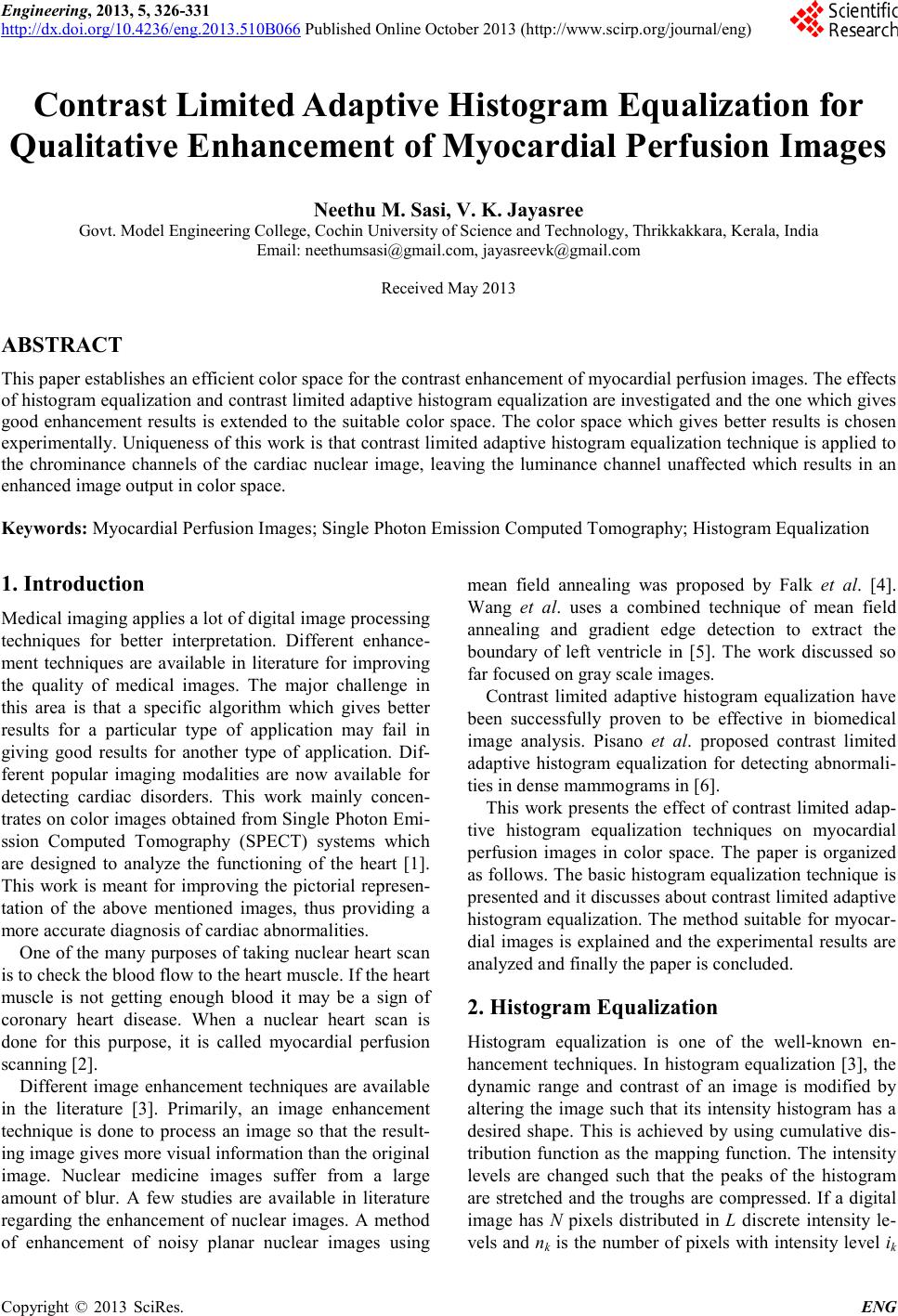
Engineering, 2013, 5, 326-331
http://dx.doi.org/10.4236/eng.2013.510B066 Published Online Octob er 2013 (http://www.scirp.org/journal/eng)
Copyright © 2013 SciRes. ENG
Contrast Limited Adaptive Histogram Equalization for
Qualitative Enhancem ent of Myocardial Perfusion Imag es
Neethu M. Sasi, V. K. Jayasree
Govt. Model Engineering College, Cochin University of Science and Technology, Thrikkakkara, Kerala, India
Email: neeth u msasi@g mail .co m, ja yasreevk@g mail .co m
Received May 2013
ABSTRACT
This paper establishes an efficient color space for the contrast enhancement of myocardial perfusion images. The effects
of histogram equalization and contrast limited adaptive histogram equalization are investigated and the one which gives
good enhancement results is extended to the suitable color space. The color space which gives better results is chosen
experimentally. Uniq ueness of this work is that contrast li mited adaptive histogra m equalizatio n technique is applied to
the chrominance channels of the cardiac nuclear image, leaving the luminance channel unaffected which results in an
enha nced image o utput in color space.
Keywords: Myocardial Perfusion Images; Single Photon Emission Computed Tomography; Histogram Equaliz a tion
1. Introduction
Medical i maging app lies a lot o f digital ima ge pr ocessin g
techniques for better interpretation. Different enhance-
ment techniques are available in literature for improving
the quality of medical images. The major challenge in
this area is that a specific algorithm which gives better
results for a particular type of application may fail in
giving good results for another type of application. Dif-
ferent popular imaging modalities are now available for
detecting cardiac disorders. This work mainly concen-
trates on color images obtained from Single Photon Emi-
ssion Computed Tomography (SPECT) systems which
are designed to analyze the functioning of the heart [1].
This work is meant for improving the pictorial represen-
tation of the above mentioned images, thus providing a
more accurate diagnosis of cardiac abnormalities.
One of the many purposes of taking nuclear heart scan
is to check the blood flow to the heart muscle. If the heart
muscle is not getting enough blood it may be a sign of
coronary heart disease. When a nuclear heart scan is
done for this purpose, it is called myocardial perfusion
scanning [2].
Different image enhancement techniques are available
in the literature [3]. Primarily, an image enhancement
technique is done to process an image so that the result-
ing image gives more visual information than the o riginal
image. Nuclear medicine images suffer from a large
amount of blur. A few studies are available in literature
regarding the enhancement of nuclear images. A method
of enhancement of noisy planar nuclear images using
mean field annealing was proposed by Falk et al. [4].
Wang et al. uses a combined technique of mean field
annealing and gradient edge detection to extract the
boundary of left ventricle in [5]. The work discussed so
far focused on gray scale images.
Contrast limited adaptive histogram equalization have
been successfully proven to be effective in biomedical
image analysis. Pisano et al. proposed contrast limited
adaptive histogram equalization for detecting abnormali-
ties in dense mammograms in [ 6].
This work presents the effect of contrast limited adap-
tive histogram equalization techniques on myocardial
perfusion images in color space. The paper is organized
as follows. T he basic histogram equalization tec hnique is
presented and it discusses abo ut contra st limited ad aptive
histogra m equalizatio n. The method suitable for myocar-
dial images is explained and the experimental results are
analyzed and finally the paper is concluded.
2. Histogram Equalization
Histogram equalization is one of the well-known en-
hancement techniques. In histogram equalization [3], the
dynamic range and contrast of an image is modified by
altering the image such that its intensity histogram has a
desired shape. This is achieved by using cumulative dis -
tribution functio n as the mapping function. The intensity
levels are changed such that the peaks of the histogram
are stretched and the troughs are compressed. If a digital
image has N pixels distributed in L discrete intensity le-
vels and nk is the number of pixels with intensity level ik